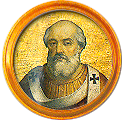Adrian
(Pope Adrian II)
di Roma
Born about [location unknown]
Son of [father unknown] and [mother unknown]
[sibling(s) unknown]
[spouse(s) unknown]
[children unknown]
Died
at about age 80
[location unknown]
Profile last modified
| Created 15 Apr 2021
This page has been accessed 158 times.
| Preceded by Nicholas I |
106th Pope of the Roman Catholic Church 14 December 867 - Nov or December 872 |
Succeeded by John VIII |
Biography
Hadrian was born in the 9th Century.[1]
Platina[2] states:
- Hadrian the Second, a Roman, son of Talarus a bishop, was a familiar friend of Pope Sergius, who having once given him forty julios, when he came home he gave them to his steward to give to the beggars and poor strangers that were at his door; which the steward going to do, saw the number was so great, that it would not serve a quarter of them, and so he returned and told Hadrian: who hereupon takes the money, and coming to the poor folks, gave every one three julios, and reserved to himself as many for his own use; at which miracle the steward being astonished, "Dost thou see" say Hadrian, "how good and bountiful the Lord is to those that are liberal and charitable to the poor?"
He became pope on 14 December 867 and his pontificate ended in either November or December 872 when he died.[1]
Flocknote Popes in a Year[3] tells us:
- Adrian was a popular and beloved cardinal of the church at the time of his election, but was an unusual choice given his advanced age (75). The Roman nobility seemed to use the election of Adrian, a relative of Popes Stephen III and Sergius II, as a response to Nicholas I giving them trouble with hard-line stances on things like, you know, nepotism and rigging papal elections.
- Adrian was still married, with one daughter, at the time of his election – it’s unclear whether or not this was considered scandalous at the time. In any case, tragedy struck in 868 when both wife and daughter were the victim of Adrian’s greedy and power-hungry family – the two were kidnapped and assassinated by Adrian’s own brother.
- Among some of the monumental tasks he had to undertake as pope, Adrian was tasked with mitigating Holy Roman Emperor Lothair’s wish to be divorced from his first wife, organizing the succession of Frankish kings following Lothair’s death, and trying unsuccessfully to convince the Bulgarian Church to ally with the West instead of the East. Easy enough, right? All in all, the papacy ended up being too unwieldy for Adrian (or anyone, probably) to have much success. He died in 872 on December 14, his fifth anniversary as pope.
- Adrian is perhaps best known for convening, along with Byzantine Emperor Basil the Macedonian, what became the Church's Eighth Ecumenical Council, the Fourth Council of Constantinople. Adrian was represented by 10 papal legates at the council, which among other things deposed Photius, a layman who had unjustly claimed the office of Patriarch of Constantinople, and restored Ignatius, his predecessor, to the seat.
- The council also reaffirmed the findings from the Second Council of Nicaea (787) in favor of using holy images and icons in the liturgy and at prayer, and required that images of Christ be granted the same veneration as that of the book of the Gospels. We see this today, for example, in how the priest or deacon will incense both the crucifix and the gospel book in the same fashion.
- Adrian II was a fan of Sts. Cyril and Methodius, having given his stamp of approval on their continued missionary work to the Slavs, and even granting them a unique privilege to have the liturgy said in the Slavonic language.
- In 870, construction on Prague Castle was begun. According to the Guinness Book of World Records, the official residence of the Czech Republic’s president is currently the largest ancient castle in the world.
Research Notes
![]() This profile is being updated by the Popes Project.
This profile is being updated by the Popes Project.
Sources
- ↑ 1.0 1.1 Vatican
- ↑ Platina, Bartolomeo (1479) The Lives of the Popes From the Time of Our Saviour Jesus Christ to the Accession of Gregory VII, I, London: Griffith Farran & Co., p230-231, retrieved 2021-04-04.
- ↑ Flocknote Popes in a Year
SOURCES (and further reading)
John, E. (1964). The Popes: A concise biographical history. New York: Hawthorn Books.
Pope Adrian II - http://www.newadvent.org/cathen/01156a.htm
Pope Adrian II - https://en.wikipedia.org/wiki/Pope_Adrian_II#CITEREFChisholm1911
Fourth Council of Constantinople - https://en.wikipedia.org/wiki/Fourth_Council_of_Constantinople_(Roman_Catholic)
Incensing the Host, Altars, Etc. - https://www.ewtn.com/library/Liturgy/zlitur132.htm
Prague Castle - https://en.wikipedia.org/wiki/Prague_Castle
Is Pope Adrian II your ancestor? Please don't go away!
 Login to collaborate or comment, or
Login to collaborate or comment, or
 contact
contact
 the profile manager, or
the profile manager, or
 ask our community of genealogists a question.
ask our community of genealogists a question.
Sponsored Search by Ancestry.com
DNA
No known carriers of Pope Adrian II's ancestors' DNA have taken a DNA test. Have you taken a test? If so, login to add it. If not, see our friends at Ancestry DNA.
No known carriers of Pope Adrian II's ancestors' DNA have taken a DNA test. Have you taken a test? If so, login to add it. If not, see our friends at Ancestry DNA.
Images: 1
Comments
Leave a message for others who see this profile.
There are no comments yet.
Login to post a comment.
Categories: 9th Century | Catholic Popes | Notables


